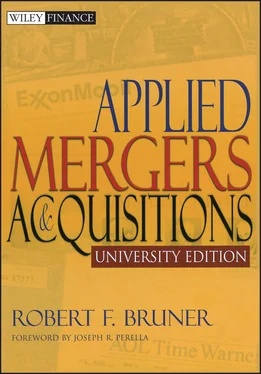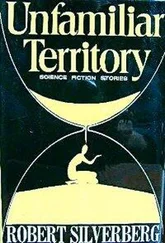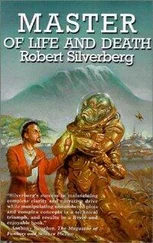2 Rational managers, irrational markets. The northeast corner accommodates the possibility of bubbles and assumes that individual managers can and will act rationally. This approach gains good traction on the explanation for why the form of payment in M&A varies with the market cycles. But it has less to say about industry clustering of M&A activity.
3 Irrational managers, rational markets. In the southwest corner is the world of managers who do stupid things for which the market reacts and penalizes them and their firms. Hubristic M&A is possible in a world with poor governance systems. But hubris says virtually nothing about M&A waves or industry clustering.
4 Irrational managers and markets. Economics has little to say about this world. When you assume away rationality, you sacrifice considerable traction from modeling and empirical research. Here, the best one can say is, “We don’t know what’s going on, but it’s probably bad.”
EXHIBIT 4.5 Explanations for M&A Activity Vary with Assumptions about Markets and Managers
| Buyer’s Managers Are: |
Markets Are: |
| Rational |
Irrational |
| Rational |
Managers and firms pursue competitive advantagewithin constraints of antitrust. With external shocksmarkets, firms, and managers respond rationally. It is difficult to determine whether negative returns to buyers are due to merger or the shock. Firms conduct M&A to exploit profitable opportunities and avoid losses. This may include exerting capital market discipline to correct agency problemsand improve governance. |
With overvaluationmarkets express irrationality. With information asymmetrymanagers are able to respond rationally on behalf of shareholders. Firms conduct share-for-share M&A to exploit overvaluation of their shares. Explains why we see many share-for-share deals near market peaks, and cash deals in the troughs. |
| Irrational |
Managers make decisions based on hubrisand markets punish the managers’ firms. Explains why firms do bad deals and why buyers’ share prices fall after the deal is done. |
Managers and markets exhibit swarm behaviorand market mania.Market prices regularly overshoot or undershoot intrinsic values. Managers display deal frenzy. Buyers’ shareholders approve acquisitions consistent with the prevailing mania, even though the deals may destroy value. |
Where in this space would you position your view? It helps to reflect deliberately on this question because how you approach the tools and concepts in the rest of this book will be colored by your fundamental assumptions about what drives M&A.
My own view is that, on average and over time, markets and managers are rational (the operative phrase here is on average and over time ). In the main, this encourages the use of tools and concepts founded on assumptions of rationality—these tools give a special benchmark for assessing deals as if markets and managers were rational. Periodically, markets and managers can lose their moorings. When they do, my practice is to cling to a value-style focus on intrinsic values and make decisions accordingly. This follows the philosophy that one must retain one’s fundamental discipline regardless of market conditions (for more on this, see Chapter 9).
“CREATIVE DESTRUCTION” AS THE DRIVER OF M&A ACTIVITY
Rationality does not necessarily dictate stability of industrial markets. The catalog of industry shocks is long. But why is it rational for them to occur? The economist Joseph Schumpeter articulated some answers with his writing on the destructive quality of business cycles. Since waves of M&A activity are roughly associated with the ebb and flow of the economic cycle, Schumpeter’s work has direct relevance to M&A activity. It is the fate of most economists to be remembered more for their path of reasoning than for their conclusions. 9 Schumpeter’s important contribution to economics was to focus attention on the key figure in economic growth: the entrepreneur. All the important economic theorists who preceded Schumpeter either ignored (e.g., Adam Smith) or scorned (e.g., Karl Marx) what the entrepreneur actually does . Schumpeter argued that the entrepreneur seeks to create turmoil, and to profit from it. This bumptious actor 10 realizes that in any stable economic setting, profits will flow to established firms doing business in established ways. He wrote:
The function of entrepreneurs is to reform or revolutionize the pattern of production by exploiting an invention or, more generally, an untried technological possibility for producing a new commodity or producing an old or in a new way, by opening up a new source of supply of materials or a new outlet for products, by reorganizing an industry and so on…. This kind of activity is primarily responsible for the recurrent “prosperities” that are due to the disequilibrating impact of the new products or methods. To undertake such new things is difficult and constitutes a distinct economic function, first, because they lie outside of the routine tasks which everybody understands and, secondly, because the environment resists in many ways that vary, according to social conditions, from simple refusal either to finance or to buy a new thing, to physical attack on the man who tries to produce it. To act with confidence beyond the range of familiar beacons and to overcome that resistance requires aptitudes that are present in only a small fraction of the population and that define the entrepreneurial type as well as the entrepreneurial function. This function does not essentially consist in either inventing anything or otherwise creating the conditions that the enterprise exploits. It consists in getting things done.11
Only by entering the competitive field with some new process or product can the entrepreneur hope to claim a cut of the profits of the industry. This describes an economy of ceaseless and self-generated change . Business cycles arise because entrepreneurs swarm or cluster around opportunities. Schumpeter wrote:
Why do entrepreneurs appear, not continuously, that is, singly in every appropriately chosen interval, but in clusters? Exclusively because the appearance of one or a few entrepreneurs facilitates the appearance of others, and those the appearance of more in ever-increasing numbers…. Hence the first leaders are effective beyond their immediate sphere of action and so the group of entrepreneurs increases still further and the economic system is drawn more rapidly and more completely than would otherwise be the case into the process of technological and commercial reorganization which constitutes the meaning of periods of boom . 12 (Schumpeter’s emphasis)
The swarming suggested by Schumpeter describes well the geographic attraction of technology entrepreneurs to places like Silicon Valley, northern Virginia, and the Boston beltway. But it also has relevance for observed clustering of M&A activity by industries. Like iron filings to a magnet, opportunity draws the M&A entrepreneur.
Why is it, then, that investment opportunities and M&A deals tend to cluster by industry? Schumpeter lays the foundation for answering this crucial question.
The essential point to grasp is that in dealing with capitalism we are dealing with an evolutionary process…. The fundamental impulse that sets and keeps the capitalist engine in motion comes from the new consumers’ goods, the new methods of production or transportation, the new markets, the new forms of industrial organization, that capitalist enterprise creates…. The opening up of new markets, foreign or domestic, and the organizational development from the craft shop and factory to such concerns as U.S. Steel illustrate the same process of industrial mutation—if I may use that biological term—that incessantly revolutionizes the economic structure from within, incessantly destroying the old one, incessantly creating a new one. This process of Creative Destruction is the essential fact about capitalism…. Every piece of business strategy acquires its true significance only against the background of that process and within the situation created by it. It must be seen in its role in the perennial gale of creative destruction . 13
Читать дальше












